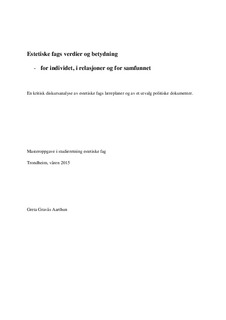| dc.contributor.author | Aarthun, Greta Gravås | |
| dc.date.accessioned | 2016-02-03T08:36:50Z | |
| dc.date.available | 2016-02-03T08:36:50Z | |
| dc.date.issued | 2015 | |
| dc.identifier.uri | http://hdl.handle.net/11250/2375775 | |
| dc.description.abstract | I denne masteroppgaven har jeg sett på hvilke individuelle, relasjonelle og samfunnsmessige
verdier som presenteres i estetiske fags læreplaner versus i fylkespolitiske dokumenter i Nord
Trøndelag. Som en teoretisk og metodisk tilnærming har jeg benyttet Faircloughs kritiske
diskursanalyse, og hans tretrinnsmodell. Problemstillingen gjør det påkrevet å identifisere
verdier i estetiske fags læreplaner før jeg kan se etter de samme verdiene i valgte fylkespolitiske
dokumenter. Jeg har systematisert funnene i flere kategoriskjema, som gjør det mulig å se på
likheter og ulikheter mellom læreplanene og de valgte fylkespolitiske dokumentene. I kritisk
diskursanalyse skal en identifisere underliggende holdninger og signaler i teksten, og prøve å
finne noen mønster. Det er, ut fra analysen, en utfordring å kunne presentere en estetisk
dimensjon i estetiske fags egne læreplaner. Et estetisk uttrykk kan ofte ikke forklares, det må
erfares. Dette vanskeliggjør de estetiske fags verdier når en skal artikulere og argumentere for
dem i politisk sammenheng der ord har makt. I skrivende stund er en nasjonal faggruppe i gang
med å utarbeide en læreplan til et nytt treårig estetisk utdanningsprogram, «Kunst, design og
arkitektur», på videregående skole. Denne masteroppgaven kan være et innspill i den
sammenhengen. Konklusjonen i oppgaven er at de verdiene som presenteres i estetiske fags
læreplaner er tekniske og teoretiske og derfor avhengig av lærerens tolkning, innlevelse og
didaktiske tilnærming til stoffet. De estetiske fags verdier som presenteres i fylkespolitiske
dokumenter spriker fra ikke verdifull i det hele tatt, til svært verdifull for individet, i relasjoner
og for Nord Trøndelags framtid | nb_NO |
| dc.description.abstract | This thesis is written with the goal of understanding the grounds upon which politicians in Nord
Troendelag base their decisions regarding the offering of aesthetic education at a high school
level. During the working process, my research changed its course to some degree, and I began
looking into the perspectives held by the county’s politicians as it pertains to the value of
aesthetic education. I ended up focusing on the following issue: “What individual, relational
and societal values are presented in the curricula of aesthetic education and how does this
contrast to the expression of those values in official policy documents in Nord Troendelag?”
This issue required an identification of the different values in the curricula of aesthetic
III
education before I could search for the same values in a chosen collection of county policy
documents.
As a theoretical and methodical approach I have used Fairclough’s critical discourse analysis
and his three-stage model. From this theory I have chosen to focus more specifically on the
concept of the “nodal point”, which becomes a headline over several synonymous terms. Every
factor (term) that belongs to the nodal point gives nuance to the wider content of the nodal
point. In this way the viewpoints and underlying significance will reveal themselves. That is
precisely what critical discourse analysis should do: search for what lies hidden in the text.
In the analysis of the curricula of aesthetic education I identified the nodal points of
communication, reflection, experience and creative abilities. From the chosen county policy
documents, the nodal points are self-confidence, well-being and rationalization. In this thesis I
have created a few forms, which systematize the nodal points by individual, relational and
societal values. This systematization makes it possible to take a look at similarities and
differences between the curricula and the policy documents. From the analysis of aesthetical
education’s curricula I see the technical, tactical and theoretical benchmarks without an
aesthetical dimension. From the county policy documents I have identified divergent
perspectives regarding the value of aesthetical education, which reveals a lack of competence
with the politicians regarding the subject. Alternatively it says something about how the
different political parties disagreeing about these values and that compromises are made
without being consequent.
Based on the analysis it becomes evident that it is a challenge to present an aesthetical
dimension in aesthetical education’s own curricula. | nb_NO |
| dc.language.iso | nob | nb_NO |
| dc.publisher | NTNU | nb_NO |
| dc.title | Estetiske fags verdier og betydning - for individet, i relasjoner og for samfunnet - En kritisk diskursanalyse av estetiske fags læreplaner og av et utvalg politiske dokumenter | nb_NO |
| dc.type | Master thesis | nb_NO |
